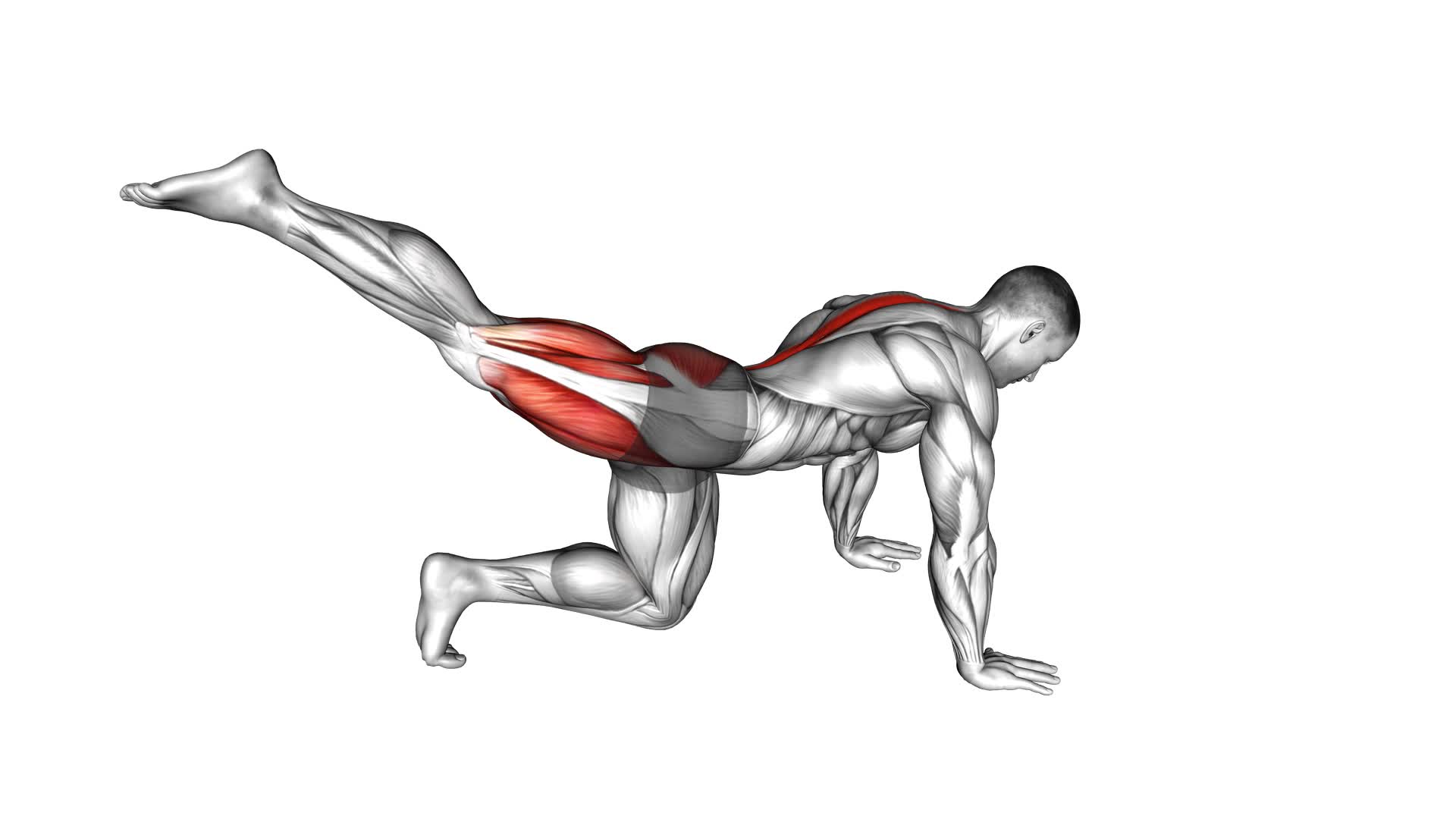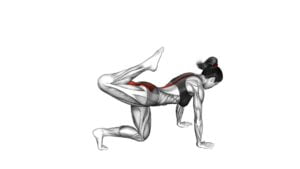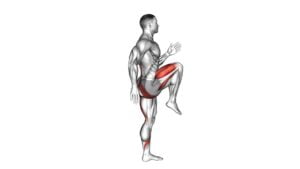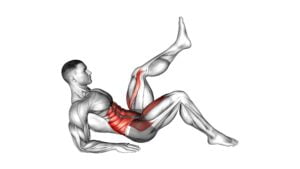Kneeling Back Leg Lift – Video Exercise Guide & Tips

Get ready to strengthen and tone your glutes with the Kneeling Back Leg Lift. This exercise targets your lower body, helping you achieve a firm and sculpted backside.
Watch This Exercise Video
In this video exercise guide, we'll show you how to properly set up and execute the movement, as well as provide variations and tips to maximize your results.
So grab a mat, press play, and let's get started on sculpting those glutes!
Key Takeaways
- The Kneeling Back Leg Lift improves glute and hamstring strength.
- It targets specific muscle groups and enhances balance.
- Proper form includes keeping the back straight, engaging the core, and squeezing the glutes.
- Variations and progressions include using resistance bands, single-arm movements, and adding weights for added challenge.
Benefits of the Kneeling Back Leg Lift
You can experience improved glute and hamstring strength through the kneeling back leg lift. This exercise not only targets these specific muscle groups but also provides benefits for improving balance. By incorporating the kneeling back leg lift into your routine, you can strengthen your glutes while also enhancing your overall stability and coordination.
To perform the kneeling back leg lift, start by kneeling on all fours with your hands directly under your shoulders and your knees under your hips. Extend one leg straight out behind you, keeping your toes pointed towards the ground. Engage your glutes as you lift your leg up towards the ceiling, maintaining a straight line from your head to your extended foot. Slowly lower your leg back down to the starting position and repeat for the desired number of repetitions.
How to Set Up for the Kneeling Back Leg Lift
To set up for the kneeling back leg lift, position yourself on all fours with your hands directly under your shoulders and your knees under your hips. This is your starting position. Make sure your fingers are spread wide for stability and your palms are firmly planted on the ground. Your knees should be hip-width apart, and your toes should be curled under for better balance. Keep your back straight and engage your core muscles to maintain stability throughout the exercise.
Once you're in the starting position, focus on your breathing. Take a deep breath in and exhale slowly as you prepare to lift your leg. As you inhale, shift your weight onto your hands and extend one leg straight out behind you. Keep your foot flexed and your toes pointed towards the ground. Lift your leg until it's parallel to the floor, or as high as you can comfortably go. Hold this position for a few seconds, squeezing your glutes and engaging your hamstring. Then, slowly lower your leg back down to the starting position.
Remember to keep your movements controlled and avoid any jerking or swinging motions. Proper form is essential to get the most out of this exercise and prevent injury.
Regular practice of the kneeling back leg lift can help strengthen your glutes, hamstrings, and lower back, improving your overall stability and balance.
Proper Form and Technique for the Kneeling Back Leg Lift
To perform the kneeling back leg lift with proper form and technique, start by positioning yourself on all fours with your hands directly under your shoulders and your knees under your hips. This exercise primarily targets the glute muscles, but it also engages the core and lower back muscles for stability.
To maintain proper form, keep your back straight and your neck in a neutral position. Engage your core by pulling your belly button towards your spine. As you lift your leg, focus on squeezing your glutes to activate the targeted muscles. Keep your knee bent at a 90-degree angle and lift your leg until it's parallel to the ground. Avoid arching your back or lifting your leg too high, as this can lead to improper muscle activation and strain on the lower back.
Common mistakes to avoid include using momentum to lift the leg instead of relying on muscle strength, allowing the hips to rotate or tilt, and lifting the leg too quickly or with jerky movements. Remember to move in a controlled manner, maintaining stability throughout the exercise.
Variations and Progressions for the Kneeling Back Leg Lift
After mastering the proper form and technique for the kneeling back leg lift, you can incorporate variations and progressions to further challenge your glute muscles and enhance your overall strength and stability.
Here are three advanced modifications for the kneeling back leg lift:
- Resistance Band Kneeling Back Leg Lift: Attach a resistance band around your ankle and secure the other end to a sturdy anchor point. As you lift your leg, the resistance from the band will provide an additional challenge for your glutes.
- Single-arm Kneeling Back Leg Lift: Instead of placing both hands on the ground, keep one hand behind your back while performing the exercise. This will increase the stabilization required from your core and challenge your glute muscles even more.
- Weighted Kneeling Back Leg Lift: Hold a dumbbell or kettlebell in the hand on the same side as the lifting leg. This added weight will increase the resistance and intensify the workout for your glutes.
When performing these variations, it's important to be mindful of common mistakes to avoid during the kneeling back leg lift. These include arching your back, relying too much on your lower back instead of your glutes, and not maintaining proper alignment. Focus on engaging your glutes throughout the movement and keep your core tight for stability.
By incorporating these advanced modifications and avoiding common mistakes, you can take your kneeling back leg lift to the next level and maximize the benefits for your glutes.
Now, let's move on to the next section for tips on getting the most out of your kneeling back leg lift.
Tips for Getting the Most Out of Your Kneeling Back Leg Lift
Maximize the effectiveness of your kneeling back leg lift by focusing on proper form and engaging your glute muscles throughout the movement. To ensure you're getting the most out of this exercise, it's important to avoid common mistakes and consider modifications that suit your fitness level.
One common mistake to watch out for is allowing your back to arch or hunching your shoulders. This can lead to strain in your lower back and take away from the targeted glute engagement. Instead, maintain a neutral spine by engaging your core and keeping your shoulders relaxed.
Another mistake is rushing through the exercise without focusing on the muscle contraction. Take your time and concentrate on squeezing your glutes at the top of the movement. This will maximize the muscle activation and help you achieve better results.
If you find the kneeling back leg lift too challenging, there are modifications you can try. One option is to use a resistance band around your ankles to provide extra support and assistance. Another modification is to perform the exercise on an elevated surface, such as a bench or step, to decrease the range of motion and make it more manageable.
Frequently Asked Questions
How Many Repetitions Should I Do for the Kneeling Back Leg Lift?
For the kneeling back leg lift, it's important to know how many repetitions to do. To get the most out of this exercise, aim for 10-15 repetitions on each leg.
This will help strengthen your glutes and improve your overall lower body strength. Remember to listen to your body and adjust the number of repetitions based on your fitness level.
Don't push yourself too hard, and always focus on maintaining proper form to avoid any common mistakes.
Can I Perform the Kneeling Back Leg Lift if I Have Knee Pain?
If you have knee pain, it may not be advisable to perform the kneeling back leg lift. This exercise puts pressure on the knees and could potentially worsen your pain.
However, there are modifications you can try, such as using a softer surface or reducing the range of motion.
Additionally, there are alternative exercises that can help strengthen your lower body without aggravating your knee pain, like standing leg lifts or glute bridges.
Can I Use Weights or Resistance Bands to Make the Kneeling Back Leg Lift More Challenging?
To make the kneeling back leg lift more challenging, you can definitely use weights or resistance bands. Adding resistance will engage your muscles even more and help you build strength. Just make sure to start with lighter weights or bands and gradually increase the intensity as you get stronger.
This modification won't only make the exercise more challenging but also help you achieve better results in your full body workout routine.
Is the Kneeling Back Leg Lift Suitable for Beginners or Should I Have Prior Strength Training Experience?
If you're wondering if the kneeling back leg lift is suitable for beginners, the answer is yes! Prior strength training experience isn't necessary.
This exercise can be modified for beginners by starting with a smaller range of motion and gradually increasing as you build strength.
If you have knee pain, there are alternative exercises available that can provide similar benefits without causing discomfort.
It's always important to listen to your body and make modifications as needed.
How Often Should I Incorporate the Kneeling Back Leg Lift Into My Workout Routine for Optimal Results?
To get optimal results from the kneeling back leg lift, you might be wondering how often to include it in your workout routine. Additionally, you may be curious about the number of repetitions you should do for this exercise.
It's important to find a balance that works for you. Remember to listen to your body and gradually increase the frequency and intensity as you build strength. Consistency is key, so aim for regular practice to see improvements over time.
Conclusion
In conclusion, the kneeling back leg lift is a highly effective exercise for strengthening and toning the muscles in your glutes, hamstrings, and lower back. By following the proper form and technique, you can maximize the benefits of this exercise.
Additionally, incorporating variations and progressions can help you challenge yourself and continue to see progress. Remember to always listen to your body and adjust the intensity as needed.
With consistency and dedication, the kneeling back leg lift can help you achieve your fitness goals.

Author
Years ago, the spark of my life’s passion ignited in my mind the moment I stepped into the local gym for the first time. The inaugural bead of perspiration, the initial endeavor, the very first surge of endorphins, and a sense of pride that washed over me post-workout marked the beginning of my deep-seated interest in strength sports, fitness, and sports nutrition. This very curiosity blossomed rapidly into a profound fascination, propelling me to earn a Master’s degree in Physical Education from the Academy of Physical Education in Krakow, followed by a Sports Manager diploma from the Jagiellonian University. My journey of growth led me to gain more specialized qualifications, such as being a certified personal trainer with a focus on sports dietetics, a lifeguard, and an instructor for wellness and corrective gymnastics. Theoretical knowledge paired seamlessly with practical experience, reinforcing my belief that the transformation of individuals under my guidance was also a reflection of my personal growth. This belief holds true even today. Each day, I strive to push the boundaries and explore new realms. These realms gently elevate me to greater heights. The unique combination of passion for my field and the continuous quest for growth fuels my drive to break new ground.







